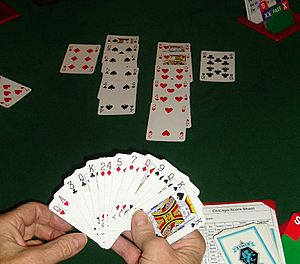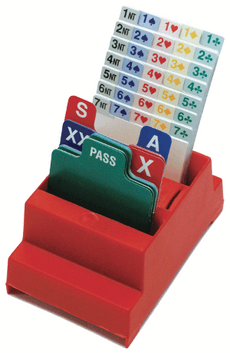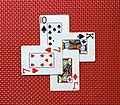Contract bridge facts for kids
Contract bridge, often just called bridge, is a fun card game. It's played by two teams of two players. Partners sit across from each other at a table.
Millions of people around the world enjoy playing bridge. They play in clubs, tournaments, online, and with friends at home. It's one of the most popular card games globally. The World Bridge Federation helps organize international bridge competitions.
The game is made up of several "deals." Each deal has four main parts:
- Dealing the cards to everyone.
- The "auction" or "bidding" phase.
- Playing the cards.
- Scoring the points.
Most club and tournament games use "duplicate bridge." This means the same cards are played by many different players. This helps compare how well each team plays the same hand.
Contents
History of Bridge
How Bridge Started
Bridge uses a standard deck of 52 cards, with four suits (clubs, diamonds, hearts, spades). The game grew out of an older card game called whist. Bridge changed and developed in steps between about 1890 and 1930. These changes happened mostly in New York and London. The game went through stages like "bridge-whist" and "auction bridge."
Nobody is quite sure where the name "bridge" came from. One idea is that it came from an 1886 book called Biritch, or Russian Whist.
Playing Bridge Differently
In whist, the special "trump" suit was chosen by chance. But in bridge, players "bid" to decide which suit will be trumps. A trump card can beat any card from the other three suits.
In whist, the team that won had to get more than half of the "tricks." A trick is when each player plays one card, and the highest card (or a trump) wins. In bridge, players bid to decide what their "contract" will be. The contract is the goal they promise to reach. It's decided by the last bid and can be in one of the four suits or "no trumps" (meaning no trump suit).
The rules for scoring and bidding changed a lot between 1890 and 1930. When you bid "one club," you're promising to win at least seven tricks. If you bid "seven no trumps," you're promising to win all thirteen tricks! "One club" is the lowest bid, and "seven no trumps" is the highest.
Bridge scoring is more complex than whist. Basically, if a player makes their contract, their team gets points. If they don't, the other team gets penalty points. Harold S. Vanderbilt helped create the scoring system. In 1927, the Whist Club of New York wrote down the rules for contract bridge. They, along with the Portland Club of London, helped guide later small changes to the rules.
The way cards are played is also different from whist. The team that wins the bidding gets to play. One player, called the "declarer," plays both their own hand and their partner's hand. The partner's hand is called "dummy," and it's placed face up on the table for everyone to see.
Duplicate Bridge Explained
The idea of "duplicate play" actually started with whist. In duplicate bridge, players don't shuffle and deal new cards for every game. Instead, the same set of cards (called a "board") is played by many different teams. This lets players compare their scores against others who played the exact same cards.
The first duplicate whist game was organized in London in 1857. It became more popular in Chicago in 1880. John T. Mitchell wrote the first book about it in 1891. His simple way of moving players and cards around is still used today.
Bridge Becomes Famous
Contract bridge became super popular in the 1930s. This was thanks to Ely Culbertson, a famous American player and organizer. Big bridge matches between American and British teams got a lot of attention in newspapers, movies, and on the radio back then.
How Bidding Works
| West | North | East | South |
|---|---|---|---|
| Pass | 1 Heart | Pass | 1 Spade |
| Pass | 2 Diamonds | Pass | 3 Spades |
| Pass | 4 Spades | Pass | Pass |
| Pass |
Look at the example on the right. West was the first player to bid. The bidding goes around the table. In this example, South becomes the "declarer" in a "4 spades" contract. This is because South was the first player on their team to bid spades.
East and West become the "defenders." West starts the game by playing the first card. North becomes the "dummy," and spades are the "trump" suit.
For a "4 spades" contract, North and South need to win at least ten tricks. This is six tricks plus the 4-level bid (6 + 4 = 10).
How Cards Are Dealt in Clubs
Bridge is often played socially in clubs. Many tables play the same set of cards. This helps compare how well each pair plays. Computers are often used to deal the cards. A special program decides which cards each player gets. Then, a machine deals the cards into special holders called "boards." These boards are then placed on the tables for players to use.
Related Pages
- American Contract Bridge League
- The Dutch Bridge Federation started in 1931.
Images for kids
See also
 In Spanish: Bridge (juego) para niños
In Spanish: Bridge (juego) para niños









